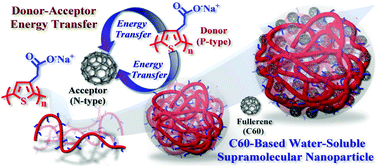Water-soluble fullerene-functionalized polymer micelles for efficient aqueous-processed conductive devices†
Abstract
This study represents an important discovery that employs donor–acceptor (D–A) energy transfer-based strategies to construct water-soluble hybrid micelles with hydrophilic sodium ion-functionalized polythiophene (PTA-Na) as a donor and hydrophobic fullerene (C60) as an acceptor, enabling the production of multifunctional self-assembled micelles for applications in environmentally friendly electronic devices. The C60-loaded micelles exhibit uniform nanospherical shape and morphology, tunable C60 loading capacity and excellent C60-entrapment stability, in combination with unique electrochemical properties due to highly efficient D–A energy transfer from PTA-Na to C60. In addition, spin-coated PTA-Na/C60 film possessed superior electrical conductivity of up to 1.85 × 10−1 S cm−1, nearly one order of magnitude higher than that of pristine PTA-Na film under the same experimental conditions. More importantly, when PTA-Na/C60 micelles were employed as the conducting layer in an aqueous-processed single-layer conductive device, the resulting device exhibited substantially higher electrical performance than control PTA-Na and C60 devices. Given its simplicity of fabrication, multifunctional properties, high efficiency and environmentally friendly characteristics, this newly-developed water-soluble heterojunction material provides a new route to enable the development of high-performance aqueous-processed electronic devices.



 Please wait while we load your content...
Please wait while we load your content...